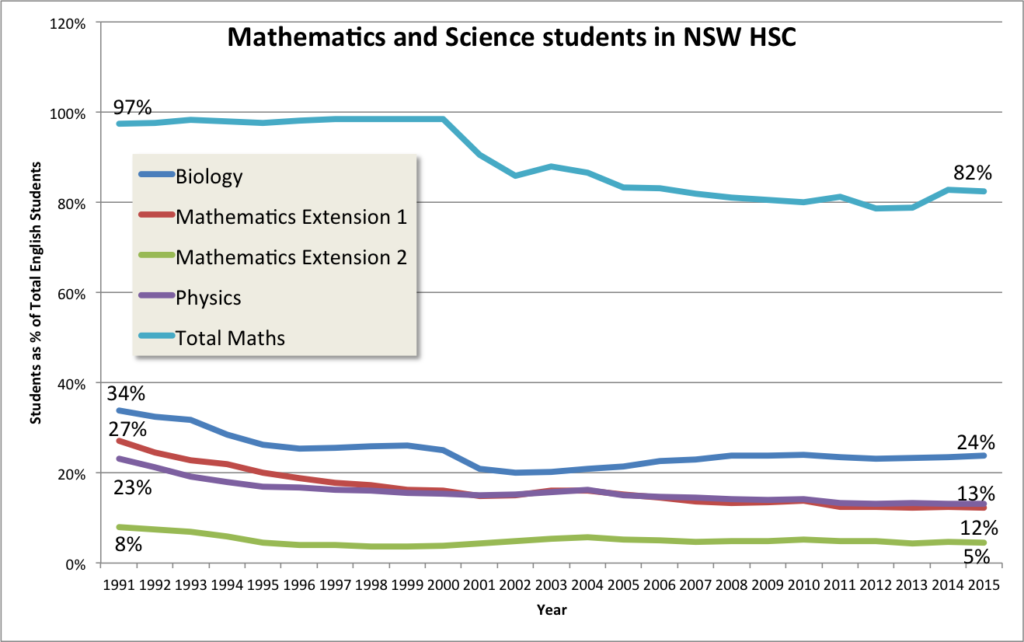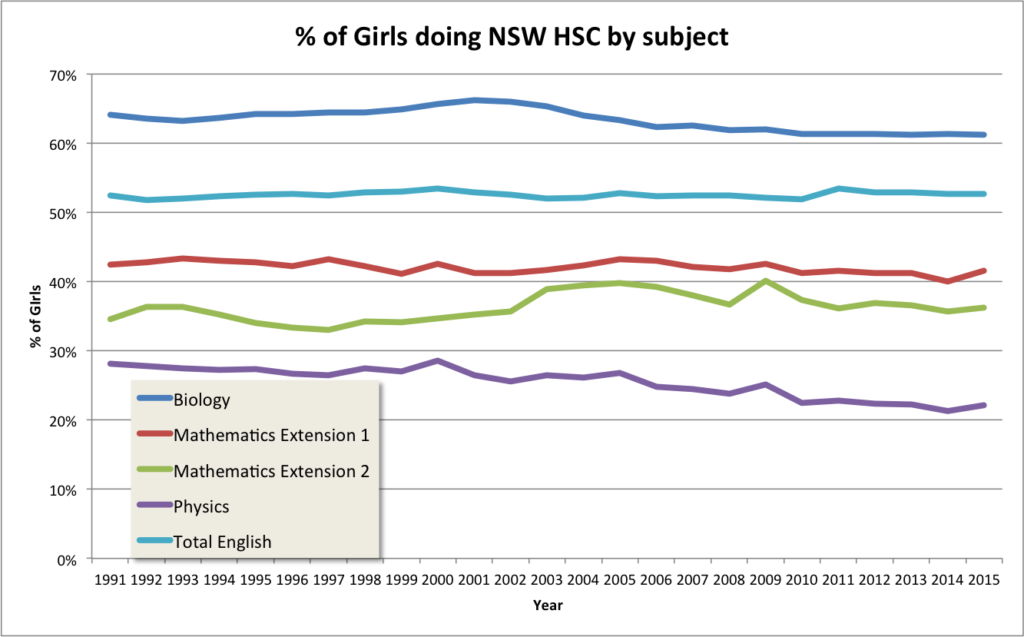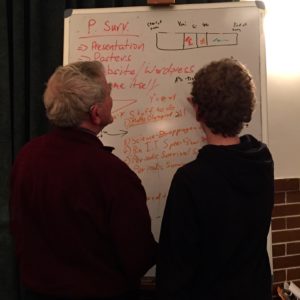 Inspired by GeekinSydney‘s recent post about HSC subjects, I took a deep dive into HSC study statistics this weekend. What I found was a bit scary for anyone who is looking for a future mathematically inclined workforce. Since 2001, when maths stopped being compulsory, the numbers of students studying maths have dropped dramatically. But it isn’t just maths. It is also the sciences, especially the hard sciences, and the proportion of students sitting the higher maths subjects.
Inspired by GeekinSydney‘s recent post about HSC subjects, I took a deep dive into HSC study statistics this weekend. What I found was a bit scary for anyone who is looking for a future mathematically inclined workforce. Since 2001, when maths stopped being compulsory, the numbers of students studying maths have dropped dramatically. But it isn’t just maths. It is also the sciences, especially the hard sciences, and the proportion of students sitting the higher maths subjects.
Back in 1991, Maths extension 1 (known then as 3 unit maths), which is the course you need to do to do a mathematical subject such as engineering at university, was taken by 27% of students studying English. Now it is taken by 12% of students studying English. Maths extension 2 (known then as 4 unit maths) which is generally a prerequisite to be an actuary, was taken by 8% of students studying English. Now it is taken by 5% of students studying English.
One of the reasons the HSC changed in 2001 (which removed the compulsion for all students to study maths) was to encourage the study of advanced level courses.
According to the 2001 press release about the HSC:
In 1995, the NSW Government appointed Professor Barry McGaw to conduct the most extensive review of the HSC in its 30-year history. The McGaw Review confirmed key community concerns about the ‘old’ HSC, including:
- too many courses, which restricted many schools from providing students with equitable access to the HSC curriculum, particularly at advanced levels of study
- a significant decline in the number of students studying advanced-level courses
- an assessment and reporting system based on scaling marks and ranking students rather than reporting the actual marks earned and describing the standards achieved
- too much focus on maximising university entrance scores at the expense of the educational needs and interests of students.
Of course, anyone who talks to a current HSC student knows that university entrance scores is still a major focus in subject choice. But the HSC certificate itself doesn’t give you a university entrance mark any more. Rather that comes from the ATAR, which is calculated by the universities.
Sadly it seems that if you count science and maths as advanced level courses, the new HSC has failed to encourage students to study them (or any changes in the ATAR). The 2002 press release trumpeted the improvement in advanced level courses (including maths):
2002 course enrolments show that the new HSC is succeeding in turning around the previous decline in advanced-level HSC study, particularly in the core subject of English. Highlights include: 3009 entries in the top-level Mathematics Extension 2 course – up by 15%.
In 2004, it was still looking promising:
In 2004 record numbers of students have taken on the top-level English, Mathematics and History courses, representing overall increases of 69%, 37% and 56% since the first new HSC Class of 2001. Mathematics Extension 2 course entries have increased to 3585 students in 2004 (up by 10% on last year and 37% since 2001).
But 2004 was the peak of the turnaround for Mathematics Extension 2, with 5.7% of the total students studying english studying Mathematics Extension 2 (the old 4 unit). But that was still well below the 8% statistic in 1991, and proved to be the peak. In 2015, 4.6% of all English students studied Mathematics Extension 2. But even worse was the subject that really matters for rigorous mathematical study – Mathematics Extension 1 (the old 3 unit). Extension 2 is really for the seriously talented mathematicians. But we want a good proportion of HSC students to be doing rigorous maths. And in 1991, a lot of them were. In 1991, there were more than 15,000 students doing 3 Unit Maths (Mathematics Extension 1) – 27% of those studying any English subject. In 2015, when the total number of English students was 30% higher, only 8,955 students (60% of the 1991 number) studied Mathematics Extension 1 – 12% of all those studying any English subject.
So if you’re looking for students who have had the rigorous training in mathematical thinking that you get from studying (among other things) calculus at school, they are going to be harder to find than they used to be. My fellow blogger geekinsydney focused on the lack of people studying maths. But in many ways, the scarier thing is that those who are studying maths are avoiding the hard stuff. To be an engineer, or a serious coder, or a systems engineer, extension maths is pretty important. But our education system is failing to produce enough students who have studied the hard maths.
The Australian Government has an Innovation Agenda:
Extraordinary technological change is transforming how we live, work, communicate and pursue good ideas. We need to embrace new ideas in innovation and science, and harness new sources of growth to deliver the next age of economic prosperity in Australia. The National Innovation and Science Agenda is an important step in the right direction.
Turning around maths and science education would be a good place to start.
__________________________________________________________________________________________________________________________________
In slightly brighter news, the proportion of girls studying the hard maths subjects (as a proportion of total candidates) has stayed pretty steady over the last 25 years. The only course that has dropped significantly has been Physics. I was glad to see that while girls have followed the boys down the rabbit hole of giving up higher maths, at least they haven’t given up in higher numbers.
___________________________________________________________________________________________________________________________________

I had a lot of fun making a pivot table of the statistics released by the NSW Board of Studies. They provide a full csv file for each year going back to 1991. But, interestingly, it is impossible using that file to work out the total students studying maths in any given year. The numbers studying each mathematics course are in the file, but the total number studying at least one maths course is not available. So my graph above is probably not accurate. I’ve done my best to add up the numbers in ways that broadly match the numbers that the Board of Studies provide for the totals, but I can’t match them exactly. I’ve assumed that if you are studying Maths extension 2, you are also studying Maths extension 1, but the details of “all students studying at least one maths subject” is impossible to match exactly.
Possibly another symptom of the lack of interest in maths and statistics from the powers that be – it is not easy to analyse the statistics from the HSC candidature itself.

Jennifer,
A sad reflection on the state of mathematics teaching. Whilst I know I my preaching to church it really is the glue that holds our modern world together.
I might say thought with the last of my children now sitting his HSC (already having got into university) this message has been completely lost. I guess it’s one of those subjects that need to me overhualed in terms of teaching.